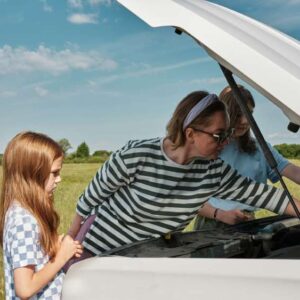Driving in winter weather poses a unique set of challenges, even for the most experienced motorists. The icy roads, reduced visibility, and unpredictable conditions require a shift in driving habits and a heightened awareness of safety measures.
This article will provide valuable car safety tips for navigating winter roads confidently and securely.
Contents
Preparation is Key
Before winter sets in, it’s crucial to prepare your vehicle. Check your battery, as cold weather can reduce its power. Ensure your lights are fully functional for optimal visibility. Install winter tires for better traction, and keep your gas tank at least half full to avoid gas line freeze-up. Remember to clear your car of snow and ice before driving, not just for your own visibility but also to prevent it from hitting other vehicles.
Adapting Your Driving Style
To adapt your driving style for safety, it’s crucial to modify your speed to align with current road conditions. Enhancing your following distance is important, particularly on slick surfaces where stopping distances are extended. Employ soft braking techniques to maintain control, and if your car is equipped with anti-lock brakes (ABS), familiarize yourself with their operation during winter conditions. In case of skidding, steer calmly towards your intended direction and refrain from abrupt braking to avoid loss of vehicle control.
Understanding Road Conditions
Be mindful of black ice, which can look like a harmless puddle but is actually a thin, transparent layer of ice. Bridges and overpasses usually freeze before the rest of the road, so approach them cautiously. Driving in a snowstorm requires using your low-beam headlights to increase visibility, even during the day.
Technology and Safety Features
Modern vehicles come equipped with safety features that are particularly beneficial in winter. Electronic Stability Control (ESC) helps maintain control in slippery conditions. Traction control can prevent wheel spin during acceleration by reducing engine power or applying brakes to specific wheels. Understanding how these systems assist you is crucial for winter driving.
Insurance and Assistance
While all these precautions can significantly reduce risk, winter driving can still lead to unexpected situations. It’s advisable to have a roadside assistance plan and to periodically compare auto insurance quotes online to ensure you have the best coverage and assistance when you need it the most.
Emergency Situations
If you get stuck in snow, keep a shovel, sand, or kitty litter in your trunk to help with traction. If you’re stranded, stay with your vehicle and use extra clothing or blankets to stay warm until help arrives. Keep an emergency kit in your car with these items, as well as food, water, and a first-aid kit.
Conclusion
Driving in winter doesn’t have to be a daunting task. With the right preparations, a mindful approach, and an understanding of your vehicle’s capabilities, you can navigate winter roads safely. Regular maintenance, cautious driving, and appropriate insurance coverage are the pillars of a worry-free winter driving experience. Always stay informed about weather conditions, and don’t hesitate to postpone your trip if the weather is too severe.
Safety is paramount, and with these tips, you’ll be better equipped to handle the challenges of winter driving.





